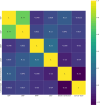Nano fuzzy alarming system for blood transfusion requirement detection in cancer using deep learning
- PMID: 38987580
- PMCID: PMC11237028
- DOI: 10.1038/s41598-024-66607-8
Nano fuzzy alarming system for blood transfusion requirement detection in cancer using deep learning
Abstract
Periodic blood transfusion is a need in cancer patients in which the disease process as well as the chemotherapy can disrupt the natural production of blood cells. However, there are concerns about blood transfusion side effects, the cost, and the availability of donated blood. Therefore, predicting the timely requirement for blood transfusion considering patient variability is a need, and here for the first-time deal with this issue in blood cancer using in vivo data. First, a data set of 98 samples of blood cancer patients including 61 features of demographic, clinical, and laboratory data are collected. After performing multivariate analysis and the approval of an expert, effective parameters are derived. Then using a deep recurrent neural network, a system is presented to predict a need for packed red blood cell transfusion. Here, we use a Long Short-Term Memory (LSTM) neural network for modeling and the cross-validation technique with 5 layers for validation of the model along with comparing the result with networking and non-networking machine learning algorithms including bidirectional LSTM, AdaBoost, bagging decision tree based, bagging KNeighbors, and Multi-Layer Perceptron (MLP). Results show the LSTM outperforms the other methods. Then, using the swarm of fuzzy bioinspired nanomachines and the most effective parameters of Hgb, PaO2, and pH, we propose a feasibility study on nano fuzzy alarming system (NFABT) for blood transfusion requirements. Alarming decisions using the Internet of Things (IoT) gateway are delivered to the physician for performing medical actions. Also, NFABT is considered a real-time non-invasive AI-based hemoglobin monitoring and alarming method. Results show the merits of the proposed method.
Keywords: Artificial intelligence; Blood transfusion; Cancer; Deep learning; Fuzzy system; Nanonetworks.
© 2024. The Author(s).
Conflict of interest statement
The authors declare no competing interests.
Figures










Similar articles
-
Deep convolutional neural network and IoT technology for healthcare.Digit Health. 2024 Jan 17;10:20552076231220123. doi: 10.1177/20552076231220123. eCollection 2024 Jan-Dec. Digit Health. 2024. PMID: 38250147 Free PMC article.
-
Artificial intelligence in clinical care amidst COVID-19 pandemic: A systematic review.Comput Struct Biotechnol J. 2021;19:2833-2850. doi: 10.1016/j.csbj.2021.05.010. Epub 2021 May 7. Comput Struct Biotechnol J. 2021. PMID: 34025952 Free PMC article. Review.
-
Discovering effect of intuitionistic fuzzy transformation in multi-layer perceptron for heart disease prediction: a study.Comput Methods Biomech Biomed Engin. 2025 Feb;28(2):197-211. doi: 10.1080/10255842.2023.2284095. Epub 2023 Nov 27. Comput Methods Biomech Biomed Engin. 2025. PMID: 38013456
-
Time series forecasting of new cases and new deaths rate for COVID-19 using deep learning methods.Results Phys. 2021 Aug;27:104495. doi: 10.1016/j.rinp.2021.104495. Epub 2021 Jun 26. Results Phys. 2021. PMID: 34221854 Free PMC article.
-
Machine learning methods for the modelling and optimisation of biogas production from anaerobic digestion: a review.Environ Sci Pollut Res Int. 2024 Mar;31(13):19085-19104. doi: 10.1007/s11356-024-32435-6. Epub 2024 Feb 20. Environ Sci Pollut Res Int. 2024. PMID: 38376778 Review.
References
MeSH terms
LinkOut - more resources
Full Text Sources
Medical

